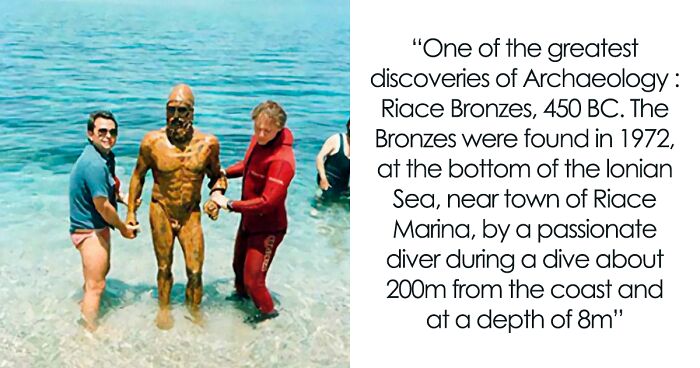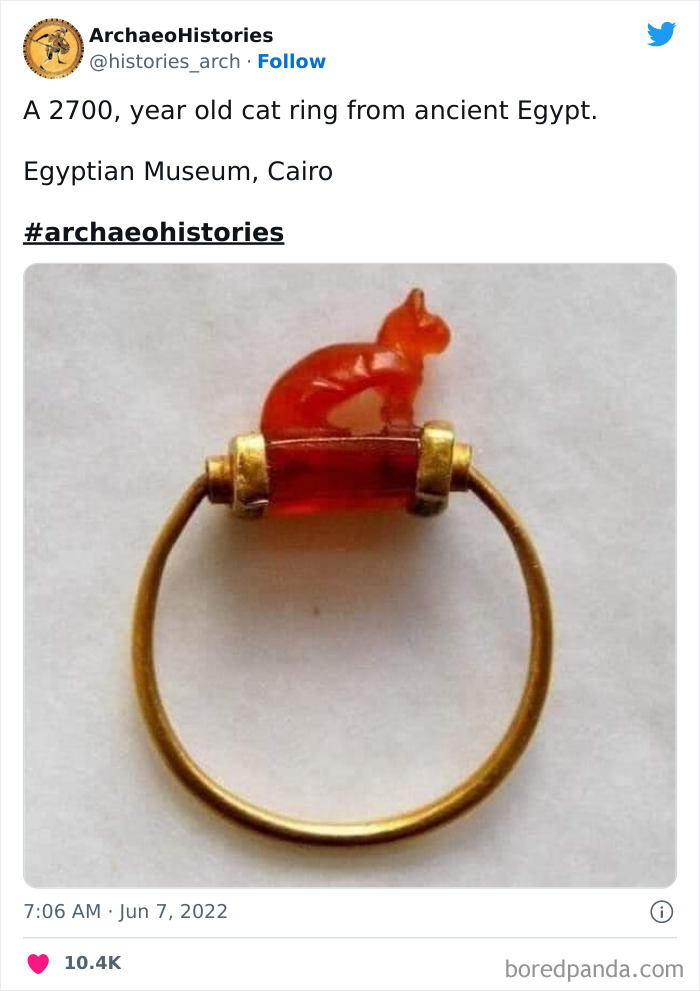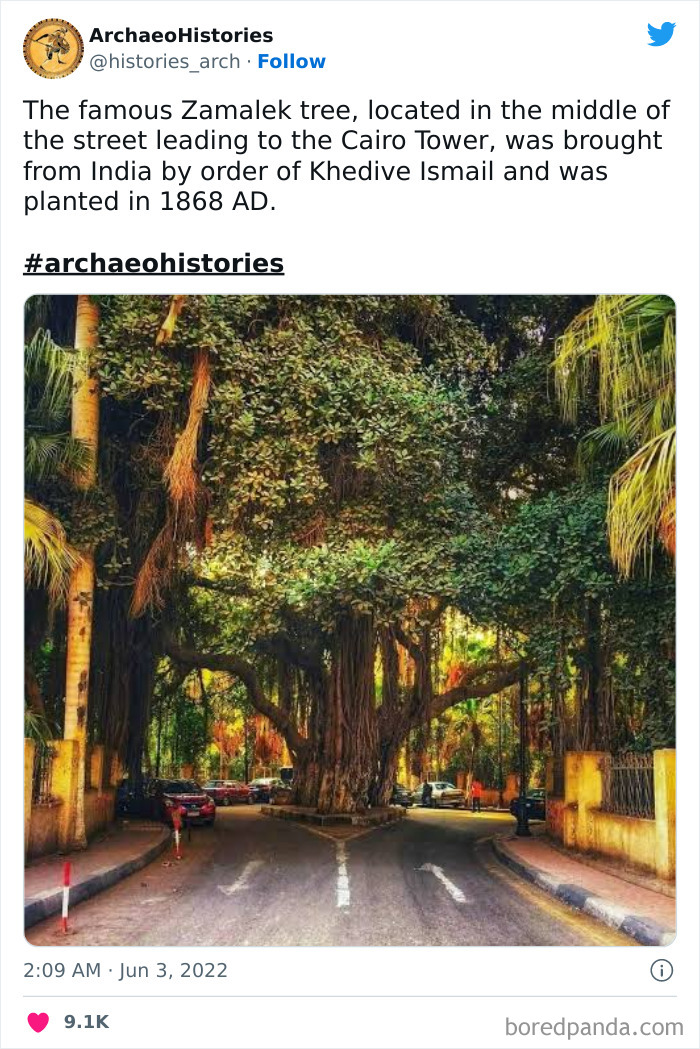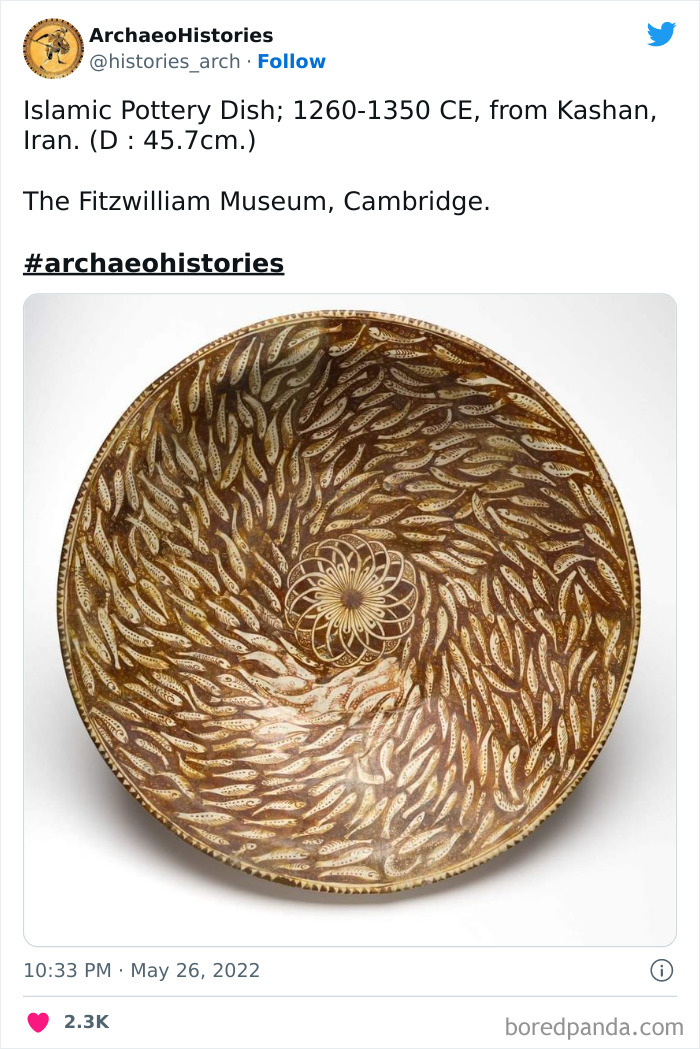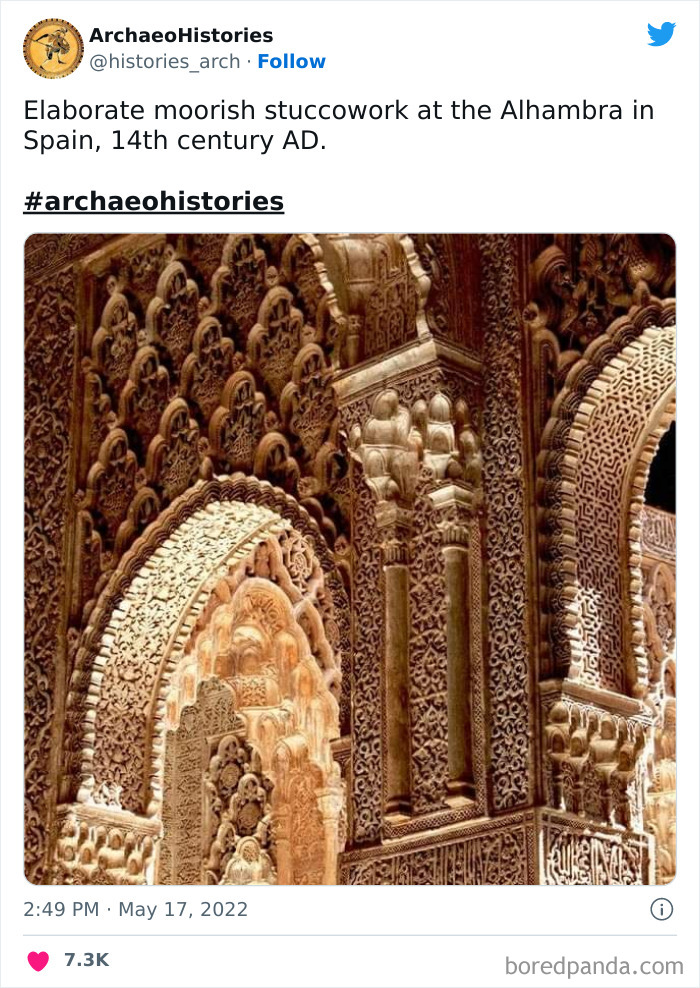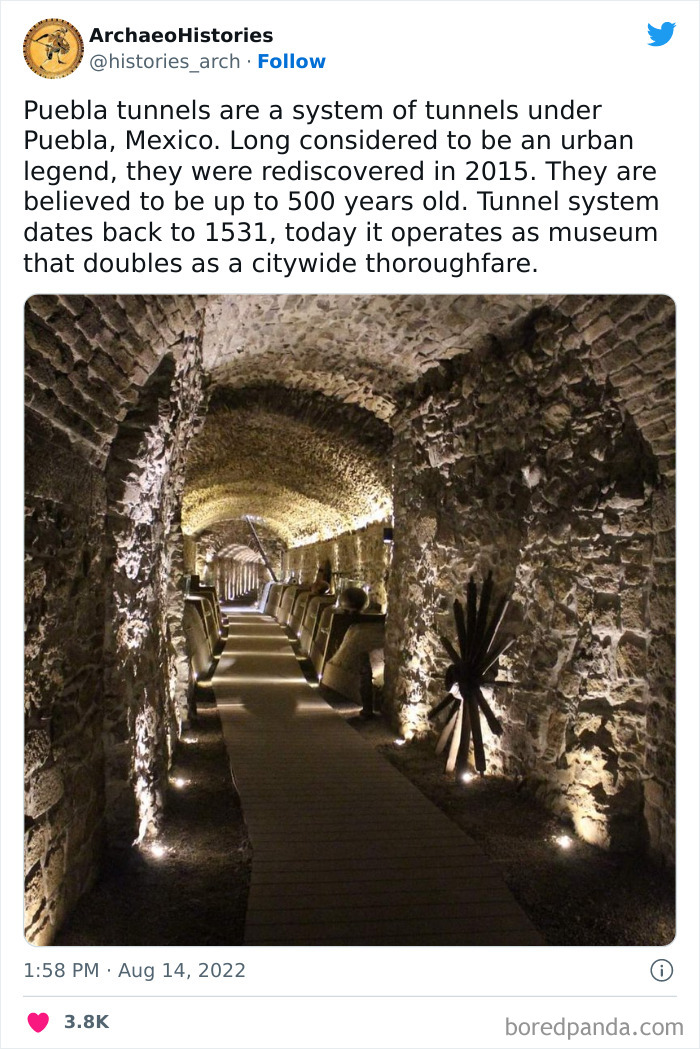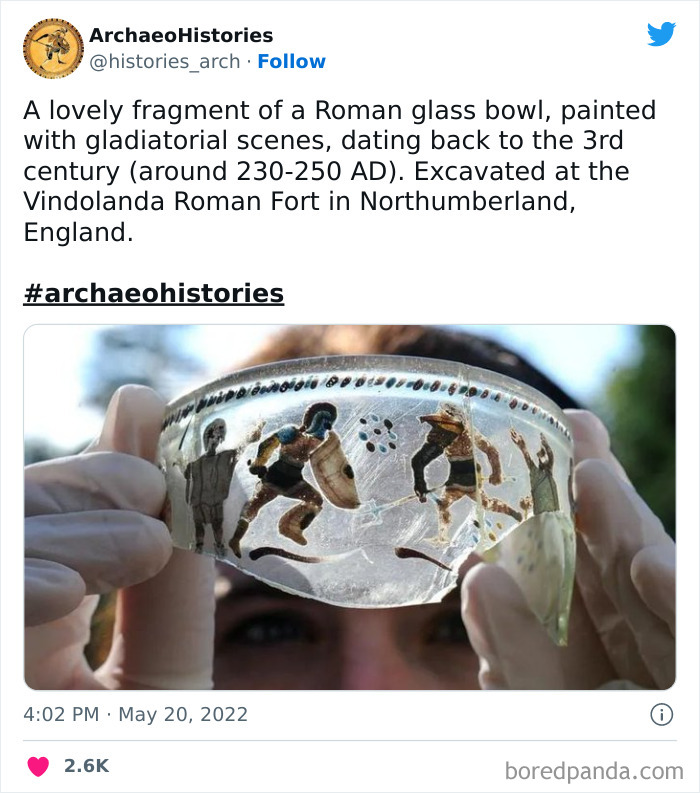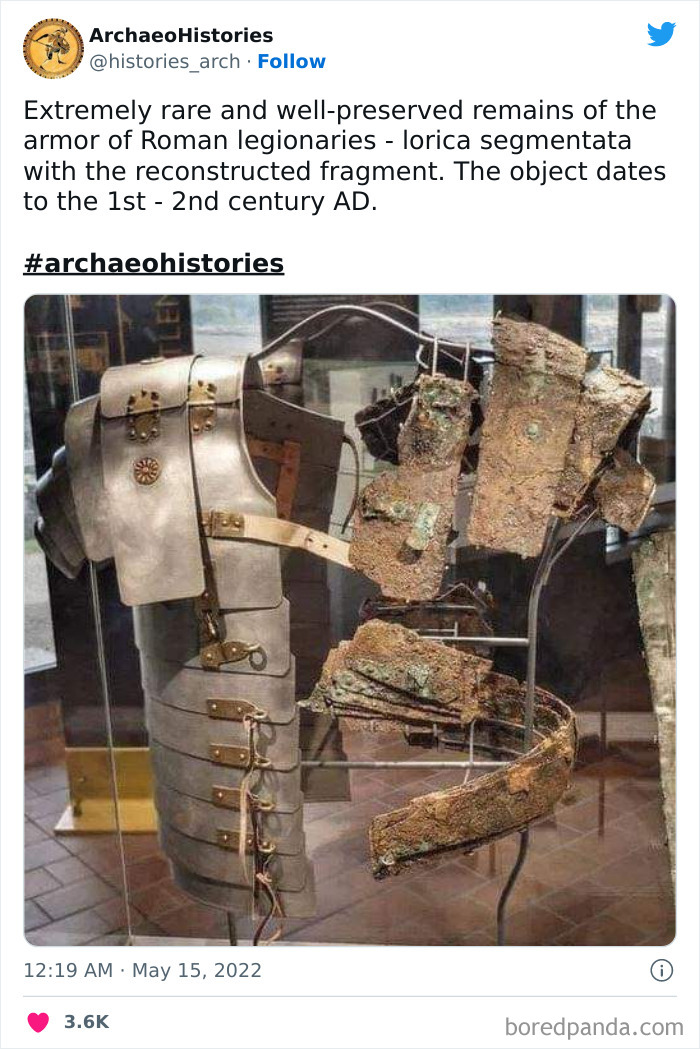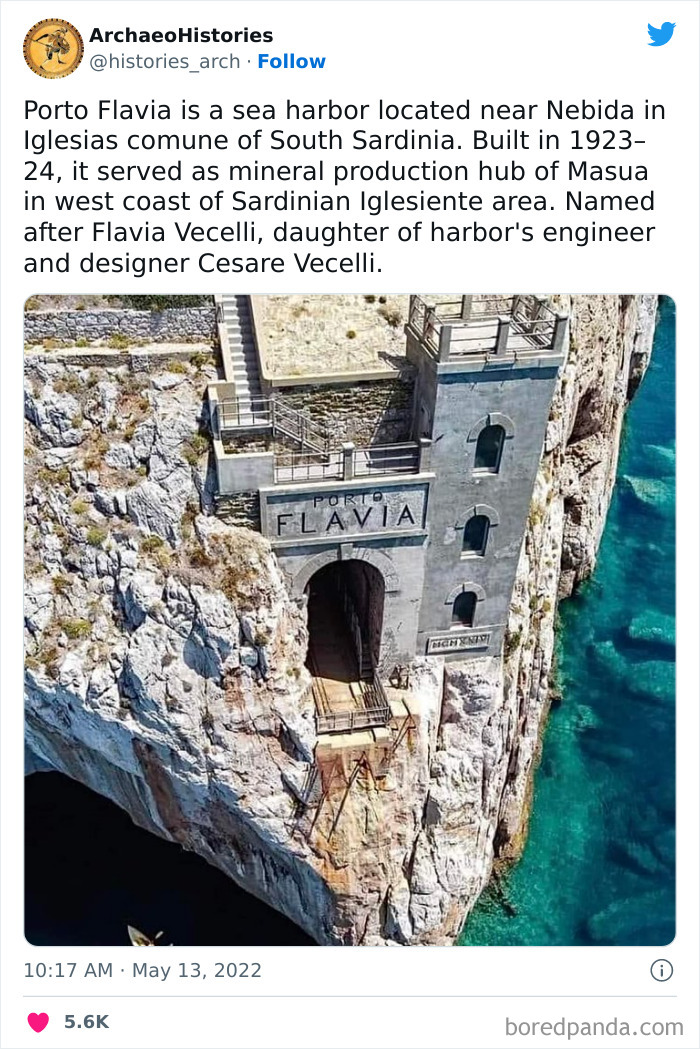Why did the archeologist go bankrupt? Because his career was in ruins!
According to the Society for American Archaeology, “Archaeology is the study of the ancient and recent human past through material remains.” This might include studying million-year-old fossils of our earliest human ancestors in Africa or even 20th-century buildings in present-day New York City. “Archaeology analyzes the physical remains of the past in pursuit of a broad and comprehensive understanding of human culture,” the SAA explains.
And if you’re interested in delving deeper into your understanding of the past, we’ve got the perfect list for you right here. We’ve gathered some of our favorite posts from the ArchaeoHistories Twitter account down below, so you can channel your inner Indiana Jones and learn a bit more about our wonderful world. Keep reading to also find interviews with Kirsten Lopez and Emily M. Long, the women behind the successful blog and podcast Women in Archaeology. Be sure to upvote the pics that blow your mind, and then let us know in the comments what the most fascinating archeological fact you know is. And if you’re looking to learn even more about archeology after finishing this piece, be sure to check out this Bored Panda article next.
This post may include affiliate links.
In the before picture, it looks as though it was breaded and deep fried. Dang it, now I want fried pickles lol
To hear from some archeology experts, we reached out to Kirsten Lopez and Emily M. Long of the Women in Archaeology podcast and blog. First, we wanted to know how these ladies got involved in archaeology in the first place and what they love most about it. "Definitely a toss up between National Geographic magazines and the History Channel (as it was in the 1990s)," Kirsten told Bored Panda. "I remember seeing a special on the History channel about Otzi and the clothing he had on that preserved in the ice of the Alps. Specifically two items: his medicine bag, and his shoes. Snow boots to be more specific. And of course, the lengths they took to continue to preserve him in a large lab freezer. After that, I was fascinated by the laboratory methods they used in archaeology to answer the most interesting of questions."
"That I think is what I love most--the hard to answer questions that take creative solutions to find an answer for, using the most seemingly unimpressive of artifacts," Kirsten explained. "Of course, it took losing everything in the 2008 financial collapse to go back to school, and have the courage to pursue archaeology. At the time, it was so seemingly pie-in-the-sky unattainable from what I knew in the working world of Southern Oregon. The first work I did was working in the curation facility at the University of Oregon's curation facility in the Museum of Natural and Cultural History. Before I ever dug a hole, I handled, cared for, and learned to analyze artifacts in a museum setting."
I want one! Also curious who it was originally made for and what that person lived like.
"Without a doubt, I had the coolest eighth grade science teacher," Emily shared. "He taught us all about Otzi the Iceman and then tasked the class to reconstruct the artifacts found with the Iceman--that was my first introduction to archaeology. I already loved history, largely due to my American Girl dolls and visiting the different Smithsonian Museums. I just had no idea that you could learn about the past by carefully studying what was left behind by people and I was absolutely hooked. I reconstructed Otzi's cape out of straw and attempted a facial reconstruction. Through that process, I learned more about experimental archaeology and bioarchaeology."
"That's one of the things that I love about archaeology as well," Emily continued. "That there are so many ways to do archaeology and categories of archaeology. I could study Egyptian architecture or Maya pottery or use satellites to discover ancient sites--all under the heading of archaeology. And, even better, the past is everywhere! There is a world of archaeology to explore."
We also wanted to hear about some of the most fascinating archaeological findings Kirsten and Emily know about. "I think the most fascinating bits are often the most unassuming," Kirsten says. "I have a strong affinity toward woven artifacts, or plant-based remains. With this, any clothing or basketry materials that last millennia take my breath away. Knowing how fast I wear through my own clothing, it can be mind blowing when fragments last over 1,000 years, let alone 12,000 or 30,000. That is what I am most interested in. The use and processing of materials to make everyday items like shoes, clothing, bags, furniture. There always seems to be a race to the oldest, 'fill in the blank' category. For me, it's more the fact that people came up with this stuff purely from experimentation, a need, and observations of the world around them. Like, how did someone figure out you can beat the inner layer of some tree bark (oak, cedar are examples) to soften and pull apart the fibers, and use those to weave soft clothing? Play, really, I think is the answer. Unstructured experimentation and play. Figuring out. What some of us like to call 'science', just with less of a written record."
"I love all of the effort and research being done on burials and skeletal remains to overturn older interpretations, interpretations like if a sword is found with a skeleton then the assumption is that the individual must be a man," Emily shared. "A more recent example is the Birka Viking Warrior burial, which was assumed to be male just based on the weapons found with the individual--but, reexamination of the remains revealed that the skeletal remains were biologically female. It's all a part of an initiative to go beyond old interpretations of sex, gender, gendered roles, as well as becoming a far more inclusive field."
I remember spotting a similar one in the ruins of a Roman villa in the bay of Naples. Fig trees are quite badass. Where I live, there is a small one growing at the bottom of a railway bridge pillar which crosses the street. It's basically trying to occupy the sidewalk there, and city services cut it all the times, but it consistently grows back and even bear figs. Makes me smile each time I pass by.
We also wanted to know if anyone can become involved in archaeology. "For sure! There are volunteer opportunities associated with university programs and field schools around the world," Kirsten told Bored Panda. "Here in the U.S., some land management agencies also have volunteer programs, such as through the Forest Service, or the Bureau of Land Management. Some areas may also have community archaeology programs for kids or adults. In the Washington D.C. area, there's a great program called Archaeology in the Community that brings kids together to learn about the history of their communities through archaeology. By learning about how archaeologists can see history differently, home or classroom activities, and field experiences. There are all sorts of programs all over the U.S., U.K., and Europe to get involved in a dig without getting a degree. Now for those more career minded, it does require a degree to become a professional, coupled with a field school. There are many programs out there, and depending on your interests, you can likely find something close to you. Nearly every state or region has local conferences and presentations open to the public. Put your feelers out there, and see what you can find. Many local universities in the Northwest used to put on archaeology, anthropology, or science talks to the public with local and visiting scholars and professionals. Often these can be found in local event pages or your local library."
"Yes!" Emily echoed. "If you want to become an archaeologist, there are great school programs, field schools, and internships. If you want to help locate and protect archaeological sites as a volunteer, there are a variety of site steward programs with the USDA Forest Service, Bureau of Land Management, and other public lands agencies. If you want to learn about archaeology, there are wonderful podcasts to check out, such as Go Dig A Hole and Archy Fantasies podcasts."
"Archaeology can seem like something exotic and far away, but archaeology is just the study of the human past through what is physically left behind," Kirsten added. "It is a way of viewing the world through a longer time scope (not as long as geology), but can give you a renewed perspective on the world. One of the most common introductory exercises for students to first step into this mindset is to think, if someone were to step into my space (house, room, office, etc.), what would they see? How would they perceive what I do, who I am or my family is, based on my stuff? Now repeat that thought exercise for the same space after a fire? Would that be different? What would they not see?"
Kirsten also left us with a philosophical quandary, "There is only so much we can know, and archaeology is one special tool to be able to see and learn things from a different perspective than, say, the written record. Most of human history is not written down, but even of that which is written, think of what isn't."
And to set the record straight, Emily added, "Archaeologists don't dig up dinosaurs, and we're nothing like Indiana Jones. Except that we punch Nazis."
If you'd like to hear more from these archaeology experts, be sure to check out Women in Archaeology right here.
Oh my goodness, that’s mindblowingly realistic, it’s like he’s looking into my soul and judging me (but somehow kindly).
The ArchaeoHistories Twitter account is still quite young, as it was launched in January 2022, but it already has over 134k followers. The page captivates readers by sharing fascinating images of ancient jewelry, artifacts, ancient architecture, ancient furniture and much more. They are sure to always provide a brief description of where these findings came from, what year or time period, where the piece is today, and whatever other information they may have on the image. This way, followers are able to learn a bit of a history lesson while they view the fascinating photos.
And because many of us have a very general understanding of archaeology (or maybe it’s just me! Any archaeologists out there?), I’ve consulted the Society for American Archaeology’s website to learn more about this interesting field of study. According to SAA, most archeologists focus on a specific region of the world or a particular topic of study. The world is just too vast to know it all, and having a specialization allows archaeologists to become experts in their chosen field.
There are a wide variety of archaeologists as well, specializing in anything from human remains (bioarchaeology) to animals (zooarchaeology) to ancient plants (paleoethnobotany) to stone tools (lithics). They can even focus on technologies that are used to find, map and analyze archaeological sites or study the remains of human activity that are hiding underwater or on coasts. Worldwide, most archaeological methods are similar, but in the Americas, archaeology is actually a subfield of anthropology. Everywhere else, it is its own independent field.
When it comes to what qualifies as an archeological site, the definition is quite broad. Any place where there is physical evidence of past human activity counts, so there are a wide variety of archaeological sites on the planet. These could be ancient villages, modern cities, shipwrecks, cemeteries, old factories, battlefields, stone quarries, campsites, a pile of chipped stones left by prehistoric hunters, and much more.
Because there is such a wide variety of archaeological sites, artifacts can also be many different things. As the SAA explains on their site, “Even the smallest archaeological site may contain a wealth of important information.” Artifacts can be any objects made, altered, or used by humans, and they can be portable like tools or non-portable, such as fences and pieces of ancient structures. Artifacts can provide great insight into what a community was like and how they lived.
One of the most important things archaeologists must keep in mind when doing their research is context. Basically, it just means that when an artifact is found, everything known about it must be recorded. Exactly where it was found and what condition it was in are vital to understanding an object’s time period and use. Without keeping meticulous records on the context of each artifact found, the pieces essentially become useless in a historical setting.
This is where Flora MacDonald, the fashion designer Alexander McQueen and my grandparents are buried.
There is infinite information out there that could fall under the umbrella of archeology, so you might be wondering what most archaeologists actually spend their time doing. Well, according to SAA, archival research is typically the first step in archaeology. This is when they dig deep into the written records of their specific field, so they understand the context of what is already known before doing any new research of their own. This can include spending countless hours in public or university libraries, studying at local historical societies or courthouses, or even visiting people’s homes. They must understand exactly what has been found and recorded at their sites before diving in themselves, and this requires an intense amount of research.
Oral history can also be very valuable to archaeologists. Not everything is recorded on paper or published in libraries. Sometimes, archaeologists need to sit down with the locals and hear what stories have been passed down by word of mouth from generation to generation. Archaeologists often collaborate with descendants people who lived in notable areas to understand the traditions and cultural significance of a place, and speaking one-on-one to individuals can be the best way to understand exactly where they are coming from. It’s one thing to read about traditions and cultures in a book, but it can be much more impactful and educational to see, hear, and experience these traditions in person.
Currently reading a book about various archaeological expeditions in Honduras.
Just a side note: the word "khanjar" means "dagger" and is basically an arabic word used in hindi and urdu languages. So I read this as "Lapis Lazuli Dagger Dagger"
Where archaeologists split off from historians is when they move into their field work. This involves the visiting of sites and often leads to manual labor. Most of us associate digging with archaeologists, but actually, SAA notes that the most important piece of equipment is the trowel. These are vital for scraping away thin layers of soil from test units or holes found in the ground. But archaeologists do require a full set of tools to complete their work, including something to dig, sift, measure and analyze any artifacts they find. And while some of these tools are specialized for the field, others are simple, everyday objects such as tape measures, toothbrushes, dustpans, and more.
wood church in Longsols ( Champagne ), FRANCE . 15th century church-630...7e30bd.jpg 
I hope you have been reading this list with the Indiana Jones theme song blaring through your head (regardless of how inaccurate of a portrayal of archaeologists he may be), and if you haven’t, well, you can always start playing it right now. Enjoy this list of fascinating artifacts, and be sure to keep upvoting the pictures of artifacts that you wish you had discovered. Let us know in the comments if you have any archaeology fun facts to share with your fellow pandas, and if you want to check out even more of these amazing photos, you can find the ArchaeoHistories Twitter account right here.
These are both way cooler than the baby carrier I have, though I do appreciate that ours is machine washable. 🙃
Château de la Rochelambert, France. 11th century chateau-63...d43d72.jpg 
Historical architecture? Certainly. Archaeological? Perhaps if studied from the perspective of architectural archaeology where the investigator examines the structure in terms of alterations and repairs through time as well as relationships with vernacular architectural traditions.
actually, one of the worst example of castles in Czech... next to Karlstein.... Because they basically rebuild it in modern history, destroyed all the medieval aspect and defending details of the castle... Its pretty but destroyed if means of history
The Alhambra is a very special in its combination of arabic and european imagery, although the overall look is mopstly moorish. The part of Spain controlled by the moors (called "Al Andalus" at the time) was an example of the religions avoiding unnecessary antagonism. When building structures like the famous "Lion's Well" and similar, the islamic builders had to rely on christian craftsmen as they were forbidden from depicting specific animals or people for religious reasons. That lead to an interesting mix in architecture - there are even some arabic names set in medieval spanish crest cartouches.
I wish I knew who it is that keeps downvoting me, no matter the comment. It is getting quite tiresome.
There is really no need for a downvote option. If people disagree they can comment accordingly or just leave a comment at zero. The downvote option allows immature behavior by a certain element.
Load More Replies...These sorts of things always make me wonder whawt people in 2-5,000 years will think when they dig up *our* relics. Hello Kitty is gonna mess with some minds!
I fear a lot of our items will not stand the test of time.
Load More Replies...Interesting, but either the wrong headline or poor logic. A lot of these are not archeological discoveries.
Very nice compilation of historical cutiosity, but some items are just not for this mix, tastes are diferent, but old door in westminter abbey are not interesting in any way, aehitectural, art or craft.
I'm blessed to be born on the land cared for by the true owners for over 70,000 years. Their countless sacred sites include cave markings over 35,000 years old showing the human face, and Stonehenge-style blocks laid out in the Pleadies constellation. Why are these not on this list?? An uninterrupted culture with over 70,000 years of wisdom gathered and passed on....
I wish I knew who it is that keeps downvoting me, no matter the comment. It is getting quite tiresome.
There is really no need for a downvote option. If people disagree they can comment accordingly or just leave a comment at zero. The downvote option allows immature behavior by a certain element.
Load More Replies...These sorts of things always make me wonder whawt people in 2-5,000 years will think when they dig up *our* relics. Hello Kitty is gonna mess with some minds!
I fear a lot of our items will not stand the test of time.
Load More Replies...Interesting, but either the wrong headline or poor logic. A lot of these are not archeological discoveries.
Very nice compilation of historical cutiosity, but some items are just not for this mix, tastes are diferent, but old door in westminter abbey are not interesting in any way, aehitectural, art or craft.
I'm blessed to be born on the land cared for by the true owners for over 70,000 years. Their countless sacred sites include cave markings over 35,000 years old showing the human face, and Stonehenge-style blocks laid out in the Pleadies constellation. Why are these not on this list?? An uninterrupted culture with over 70,000 years of wisdom gathered and passed on....

 Dark Mode
Dark Mode 

 No fees, cancel anytime
No fees, cancel anytime 







